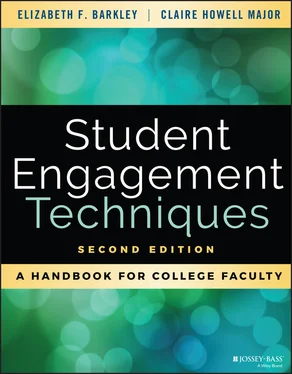Elizabeth F. Barkley - Student Engagement Techniques
Здесь есть возможность читать онлайн «Elizabeth F. Barkley - Student Engagement Techniques» — ознакомительный отрывок электронной книги совершенно бесплатно, а после прочтения отрывка купить полную версию. В некоторых случаях можно слушать аудио, скачать через торрент в формате fb2 и присутствует краткое содержание. Жанр: unrecognised, на английском языке. Описание произведения, (предисловие) а так же отзывы посетителей доступны на портале библиотеки ЛибКат.
- Название:Student Engagement Techniques
- Автор:
- Жанр:
- Год:неизвестен
- ISBN:нет данных
- Рейтинг книги:3 / 5. Голосов: 1
-
Избранное:Добавить в избранное
- Отзывы:
-
Ваша оценка:
- 60
- 1
- 2
- 3
- 4
- 5
Student Engagement Techniques: краткое содержание, описание и аннотация
Предлагаем к чтению аннотацию, описание, краткое содержание или предисловие (зависит от того, что написал сам автор книги «Student Engagement Techniques»). Если вы не нашли необходимую информацию о книге — напишите в комментариях, мы постараемся отыскать её.
— — — —
Student Engagement Techniques
"Student Engagement Techniques
"Student Engagement Techniques
"This book is an essential resource for faculty seeking to better engage with their students. Anyone seeking a clear, research-based, and actionable guide needs a copy of Student Engagement Techniques on their shelf!"
Student Engagement Techniques — читать онлайн ознакомительный отрывок
Ниже представлен текст книги, разбитый по страницам. Система сохранения места последней прочитанной страницы, позволяет с удобством читать онлайн бесплатно книгу «Student Engagement Techniques», без необходимости каждый раз заново искать на чём Вы остановились. Поставьте закладку, и сможете в любой момент перейти на страницу, на которой закончили чтение.
Интервал:
Закладка:
We also note that although students may find one (or even several) course activities engaging, the kind of intense and sustained student engagement that most teachers strive for is a byproduct of a larger, integrated effort. This includes implementing the principles of good teaching, such as establishing clear and significant learning goals, holding students to high expectations, and giving them prompt feedback. But it also requires something both deeper and less tangible: approaching teaching with the aim to honor students by
[g]enuinely engaging their spirit, their experience, and their perspective. A mere strategy does not create such a milieu. [It is] the result of a determined living harmony, a constancy of practices blended with ideals from the beginning to the end of every lesson of every session of every course. (Wlodkowski, 2008, p. 169)
Thus, in the following sections, we turn our attention to how teachers can work to create synergy between motivation and active learning.
Chapter 4 Promoting Synergy Between Motivation and Active Learning
IN OUR MODELof student engagement, motivation and active learning are twin helices that work together synergistically. How can we promote this synergy? We propose that there are classroom conditions that function somewhat like steps or rungs between the two sides of the double helix spiral. These conditions, because they integrate elements of both motivation and active learning, contribute to the synergy that promotes increased levels of engagement.
Condition 1: Teachers Can Promote Synergy by Creating a Sense of Classroom Community
If we had only our own observations of the ubiquitous use of cell phones on campus, we'd probably conclude that staying connected to other people is important to today's students. But this desire to be part of a social community is also reported in the research. In Millennials Go to College , generation analysts Howe and Strauss (2007) identify “Team-Orientation”—with its tight peer bonds and expectations to stay in constant contact with large circles of friends and acquaintances—as one of the seven core traits that define this cohort of college students. In a study of undergraduate student cell-phone use, Roberts, Petnji, Luc, and Manolis (2014) found that students in their sample ( n = 164) reported that they spend an astonishing 8–10 hours per day on their cell phones. In a study of Ohio University students ( n = 50) asking them to refer to the screen time feature on their phones when reporting results, the researchers found that students spent an average of 4.75 hours on their phones per day (Wein, 2019). Exploiting this predilection for social connections, college marketing departments publish “viewbooks” filled with photos of students in groups talking amiably together. Used as recruitment tools, the books send a visual message to prospective freshmen that they will find a vibrant campus community at that institution.
Recognizing the importance of campus community is not new. Residence halls, student clubs, campus activities, and sororities and fraternities are all extracurricular examples of ways institutions foster a sense of students belonging to a social community. Across the curriculum, educators hope students will work diligently to become part of a community of scholars. In between the social community fostered by the “extracurriculum” and the earned membership into the scholarly community that is typically signified by graduation, is the curriculum—the courses where students have traditionally been expected to do their work individually and independently. Students sit in rows facing the professor, and are urged to refrain from talking to each other because this is disruptive and distracting. Fortunately, that model is now changing, with many educators proposing that optimal, engaged classroom environments are those in which the teacher and students perceive themselves as members of a learning community.
Although there is debate in the literature over the definition of learning communities (with “purposeful pairing of courses” a common definition), for our purposes in discussing student engagement in a single classroom, we shall adopt Cross's (1998c) definition of “groups of people engaged in intellectual interaction for the purpose of learning” (p. 4). The term “learning community” seems appropriate for two reasons. First, it places the emphasis on learning. Second, the term suggests that this learning occurs within a community—a group of people working together with shared interests, common goals, and responsibilities toward one another and the group as a whole (Brophy, 2004). In a learning community, the overarching goal is learning, but this learning is best achieved in environments where students feel a sense of belonging, and where they are comfortable responding to questions when they are unsure of the answer and seeking help from the teacher or from their peers when they don't understand. Building learning communities that help students feel connected to rather than isolated or alienated from the teacher and their classmates addresses a basic, motivational human need to be part of a social community.
The effectiveness of promoting the interaction that characterizes a learning community is well documented. Pascarella and Terenzini's (1991) first synthesis of the research on the impact of college on students concluded that a large part of students' gains in college in terms of factual knowledge and a range of general cognitive and intellectual skills is determined by the extent to which students interact with faculty members and student peers in and out of the classroom (p. 620). In their follow-up work synthesizing research conducted in the 1990s, they comment on the “broad spectrum” of research on group work as a pedagogical approach and state, “The weight of evidence from this research is reasonably consistent in suggesting that collaborative learning approaches can significantly enhance learning” (2005, p. 103). They describe a study by Karabenick and Collins-Eaglin (1997) that used data from over 1,000 students in 57 classes and found that the greater the class emphasis on collaborative learning and the lower the emphasis on grades, the more likely students were to use higher-order learning strategies of elaboration, comprehension monitoring, and critical thinking (2005, p. 180).
In another study, Pascarella and Terenzini (2005) took the raw data from a meta-analysis of 43 experimental and quasi-experimental studies by Qin, Johnson, and Johnson (1995) that considered the effects of cooperative versus individualistic or competitive learning approaches on general problem-solving skills. Four types of problems were considered: linguistic (problems solved in written or oral languages); nonlinguistic (problems represented in pictures, graphs, symbols, mazes, or formulas); well-defined problems with precise operational procedures and solutions (such as a chess problem); and ill-defined problems (problems that do not have clear procedures or solutions, such as deciding which car to buy). Pascaraella and Terenzini removed 20 of the 43 studies that were carried out in postsecondary samples, conducted their own meta-analysis, and concluded that “college students learning in cooperative groups had a statistically significant advantage in overall problem solving of .47 of a standard deviation” and that the advantage in problem solving was essentially the same for both well-defined problems and ill-defined problems (p. 180).
Collaborative learning is also in alignment with the model that knowledge is socially constructed rather than discovered. Bruffee (1993), in his philosophy of nonfoundational social construction, proposes, “We construct and maintain knowledge not by examining the world but by negotiating with one another in communities of knowledgeable peers” (p. 9). Finally, building classroom learning communities in which all students feel respected and valued may also address criticisms by Bensimon (2007) and others of some definitions of student engagement. Their critiques express concern that current approaches to measuring student engagement are part of a dominant paradigm that fails to take into consideration theories about marginalized groups, focusing too much on the student's lack of engagement, and not enough on exposing the existing structures that disempower students. They emphasize the responsibility of institutional agents to create more empowering and engaging conditions for all students to succeed. College teachers can support institutional efforts toward this goal by helping all students feel that they are included, honored, important, contributing members of a learning community. In short, creating conditions in which students interact with each other as members of a learning community promotes student engagement and creates synergy between motivation and active learning: It fulfills the basic human need to be part of a social community and also encourages students to learn actively as they collaboratively construct, reconstruct, and build their understanding.
Читать дальшеИнтервал:
Закладка:
Похожие книги на «Student Engagement Techniques»
Представляем Вашему вниманию похожие книги на «Student Engagement Techniques» списком для выбора. Мы отобрали схожую по названию и смыслу литературу в надежде предоставить читателям больше вариантов отыскать новые, интересные, ещё непрочитанные произведения.
Обсуждение, отзывы о книге «Student Engagement Techniques» и просто собственные мнения читателей. Оставьте ваши комментарии, напишите, что Вы думаете о произведении, его смысле или главных героях. Укажите что конкретно понравилось, а что нет, и почему Вы так считаете.












